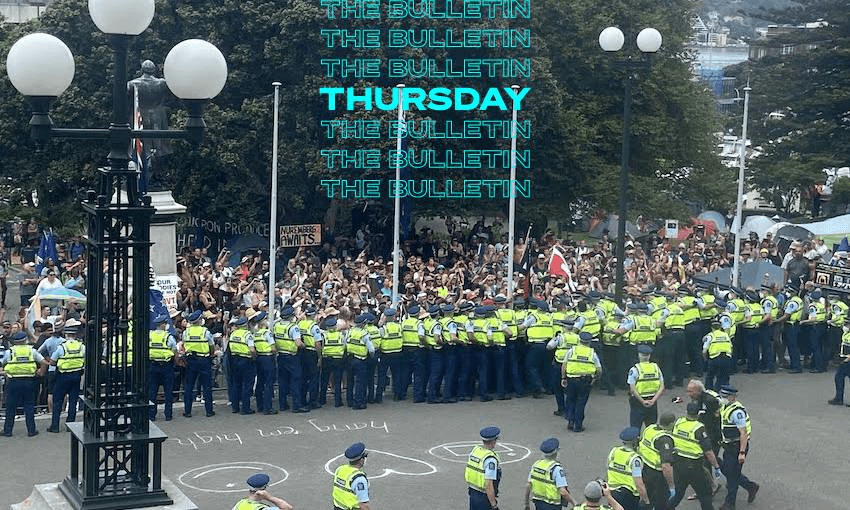Justin Giovannetti writes a dispatch from the front steps of parliament where a message of freedom is clashing with threats of lynching
A mixture of peace and anger outside parliament. A Canadian journalist reporting on the ongoing protests in that country shared a picture earlier this week that perfectly captures the contradiction built into ongoing anti-mandate occupations around the world. The picture showed a professionally-made sign that read “Facts over fear”. However, a protester had then taken a marker and written “Stop raping kids!” on the sign, echoing the far-right QAnon conspiracy. So it was yesterday in Wellington that a protester holding a “Love not fear” sign was yelling death threats at a One News reporter. Speakers called for “dignity and peace,” while there were nooses in the crowd and someone had scrawled “Hang ‘em high” at the base of parliament’s steps.
The protest has brought together a number of groups that defy definition. With a mixture of slick “freedom” branding and hateful signs promising executions, there’s no single story to be told about the convoy that arrived at parliament on Tuesday. The contradictions were bewildering yesterday as I watched from parliament as the crowd seemed uncertain about what to do next, beyond waiting for the government to cave to their ill-defined demands. As Toby Manhire reports for The Spinoff, some of those fractures were also becoming clear to the protesters themselves. Rival leaders are clashing over the approach and message coming through loudspeakers. Some demonstrators are genuinely driven by opposition to vaccine mandates, while others are more concerned with far-right American conspiracy theories. According to Stuff, MPs are united in opposition to what’s happening outside the seat of New Zealand’s democracy.
The Wellington protest reflects a global movement. Dylan Reeve writes about the internet for The Spinoff and spends a significant amount of time monitoring far-right groups and conspiracies online. He’s written about the international protest movement that led to the demonstration outside parliament this week. One thing that’s clear from his reporting is that the New Zealand protest has broken from the Canadian model it is trying to emulate in one big way. The Canadian protest started in opposition to a specific border mandate and seems to be dominated by truckers and people in work vehicles. New Zealand’s isn’t. I asked Reeve to help explain what’s going on.
What is this all about? “That really depends on whether we look at what the organisers say outwardly or what the participants themselves say. If we look at the former, then the convoy was a protest to end pretty much all Covid restrictions.
“But many of the participants themselves adorned vehicles and carried signs putting forward more extreme ideas, including anti-vax conspiracies, QAnon-inspired ideas and demands for the arrests of politicians, officials, scientists and the media.”
Who are the people at this protest? “Again we’re faced with the question of what they say versus what we see. The convoy was often branded as a ‘truckers convoy’ which is an idea imported from Canada where it was probably more accurate. In reality they are largely the same people we’ve seen at literally every protest about Covid, with incredibly wide-ranging views and beliefs. I think many of the people who may have joined the protest initially were perhaps on the less-extreme end of the spectrum, but after a couple of days, it looks like only the more deeply involved have remained.”
How much of this is driven from overseas? “There has been some really interesting reporting all through the pandemic about the ways in which well-resourced political groups have exploited and encouraged oppositional movements. Most recently it seems like there’s some very questionable people and groups propping up in the Canadian convoy. I haven’t really seen much to suggest that stuff happens directly here, but the globalised nature of the protest movement means that even without direct involvement in New Zealand, what happens overseas quickly filters into and energises local groups.”
Where do we go from here? “For the convoy? Probably nowhere. It’s likely the protest will eventually peter out. It seems incredibly unlikely they will achieve any of their stated objectives.
“But in a broader sense this is a question I’ve been wondering about since early in the pandemic. I’ve long believed people fall into conspiracy theory rabbit holes often through innocuous inquiry, perhaps a little uncomfortable about vaccines, they find a site espousing anti-vax ideas and soon trust that site for other information too. Once you’re in those spheres there’s no end of new ‘knowledge’ being shared, and it’s easy to become quite radicalised about pretty extreme conspiracy theories.
“I suspect that’s been happening on an even bigger scale during Covid, especially since the vaccines arrived. Now there’s a sizeable group who are buying into bigger conspiracy ideas beyond Covid. So even if the pandemic somehow fades away, they’re not necessarily going back to who they were before.”


